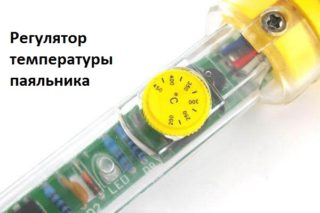Without exception, all wiring diagrams provide for branching and connection of cables and wires. For this, it is required to additionally install a junction box, which is made of metal or polymer materials. However, it is not enough to install the structure, it is important to know the technology of soldering wire twists in the junction box.
- What are junction boxes for?
- General rules for commutation
- The advantages of soldering compared to other connection methods
- Soldering wires
- Soldering iron power selection
- Solder type
- Protection of the soldering point against oxidation
- Soldering and tinning technology
- Soldering with torch and crucible
- Precautions
What are junction boxes for?
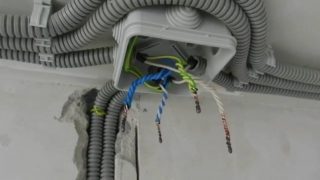
The necessity of using junction boxes should not be in doubt. To make sure of this, you should read the warnings of specialists:
- Neglect of the installation of the structure is a violation of the rules set out in the regulatory documents.
- Compliance with fire safety. Thanks to RK, the likelihood of short circuits and fire is significantly reduced, due to the tightness of the structure.
- Installation of the device will take a lot of time, but in the future it will be much easier to modernize, maintain, repair and build up wires. For example, if you need to install an additional outlet or switch, the necessary wires can be removed from the junction box.
In general, the installation of the junction box is required. The installation technology is simple, the complexity may arise when connecting wires.
General rules for commutation
The implementation of the soldering method resembles welding, only an ordinary soldering iron is used, and not an inverter machine with electrodes. Before twisting, the veins must be tinned. To do this, the soldering iron is warmed up, immersed in rosin and carried over the areas cleaned from insulation several times until a reddish tint appears.
For quality work, you must first check the soldering iron tip. It is important to keep it clean. If the surface is uneven, dirt has accumulated on it, it will be impossible to make high-quality solder. The dirt is removed with a file, then its end is re-tinned.
The advantages of soldering compared to other connection methods
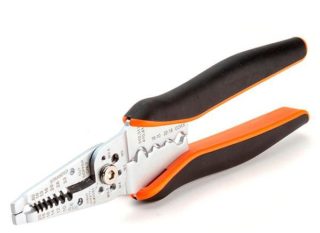
There are several ways to connect wires in a junction box, however, only soldering and welding differ in the minimum contact resistance and monolithic connection. Anyone can solder wires at home. For welding, you will need experience and a special welding machine.
To carry out the work, you will need the following set of tools:
- flux;
- a knife designed to remove insulating material;
- solder;
- side cutters;
- soldering iron;
- pliers or pliers;
- sandpaper.
Without first preparing all the necessary tools and consumables, you cannot start work.
Soldering wires

Tinning and soldering of cables in the junction box is carried out in several stages.
- Removing the insulating layer.
- Stripping the wires until the characteristic shine of the metal appears.
- Service.
- Twisting.
- Soldering.
- Isolation.
Before proceeding with the connection of the conductive cores, you need to analyze how much length is required. Cut the wires so that when soldering, the ends are located outside the junction box. At the end of the work, they are laid in any desired way.
Soldering of wires in the junction box is prohibited in tightness. The stock in this case is also inappropriate.
To remove the insulating layer, a special tool is used - a stripper or a sharp knife. When working with a sharp knife, the movements should resemble shaving off a pencil. It is forbidden to cut the insulating layer with pliers or side cutters, it is not allowed to make circular cuts. Transverse damage will cause breakage in the near future.
For a wire intended for soldering, the stripping ranges from 1.5-3 cm.The number of turns is at least 2.

Before soldering, the wires are carefully cleaned and tinned so that oxides do not appear on the surface of the conductors, which interfere with normal conductivity and increase resistance. Already tinned conductors are twisted using pliers or pliers.
Soldering twisted copper wires in a box has a similar algorithm. The twist should be tight, but not taut, otherwise the ends of the conductive veins may simply break off.
Finally, the twisted wires are soldered with a soldering iron so that the solder is covered with a uniform layer on all sides. The quality of the work depends entirely on how well the ends were cleaned.
Soldering iron power selection
The device should optimally warm up the place for 1 minute or more, the surface of the solder at the end of the work should be smooth, have a uniform shine.
Solder type
There is a wide variety of solders, the main ones are listed in the table.
| Solder grade | Structure (%) | Tensile Strength (kg / mm) | Melting temperature | Application |
| POS-30 | Lead - 70 Tin - 30 | 3,2 | 266 | For soldering and tinning of parts made of steel, copper and their alloys |
| POS-40 | Lead - 60 Tin - 40 | 3,8 | 238 | For soldering and tinning contacts and parts in radio equipment made of galvanized steel |
| POS-90 | Lead - 10 Tin - 90 | 4,9 | 220 | For soldering and tinning of medical instruments and metal utensils |
| POS-61M | Copper - 2 Lead - 37 Tin - 61 | 4,5 | 192 | For soldering and tinning printed conductors and copper wires |
| POS-61 (tretnik) | Lead - 39 Tin - 61 | 4,3 | 190 | For tinning and soldering live parts made of bronze, brass and copper with sealed seams |
| POSV-33 | Bismuth - 33.3 Lead - 33.3 Tin - 33.3 | — | 130 | For soldering parts made of constantan, brass and copper with a hermetic seam |
| POSV-50 (Alloy Rose) | Bismuth - 50 Lead - 25 Tin - 50 | — | 94 | For machining parts that are susceptible to overheating |
| Alloy d Arce | Bismuth - 45.3 Lead - 45.1 Tin - 6.9 | — | 79 | For the production of fuses, tinning and soldering of parts susceptible to overheating |
| Wood's alloy | Cadmium - 12.5 Bismuth - 50 Lead - 25 Tin - 12.5 | — | 68,5 | An important feature is toxic. Designed for the manufacture of fuses, tinning and soldering of parts susceptible to thermal effects |
The last three grades have a low melting point and low alloy strength.
Protection of the soldering point against oxidation
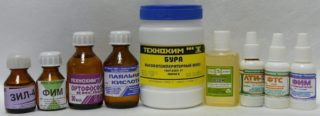
A flux is used to protect the soldering point from oxidation by oxygen. When working with copper, the following are most often used:
- Rosin, it contains only pine rosin.
- LTI-120 includes triethanolamine (1-2%), aniline hydrochloric acid (3-7%), ethyl alcohol (66-73%), rosin (20-25%).
- The alcohol rosin contains ethyl alcohol (60-70%) and rosin (30-40%).
The simplest, budgetary and at the same time common version of the flux is ordinary rosin. The only difficulty that can arise when working with a substance is a solid state of aggregation.
Soldering and tinning technology
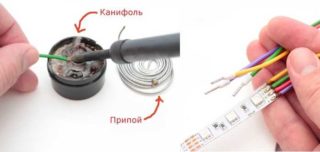
When starting soldering or tinning wires, it is important to place the latter horizontally so that the tip of the soldering iron touches all sides unhindered. Some "experts" recommend placing the conductors vertically, but this should not be done, as the solder drops may start to spread.
Before tinning, the wires are heated with a soldering iron and in parallel touch the heating site with a piece of rosin until it begins to melt. If a liquid flux is used, it is applied beforehand even before the start of heating. After tinning, the wires are twisted.
The soldering technique is slightly different as more solder is required. A flux is applied to the conductive conductors and heated with a soldering iron until the molten drop is evenly distributed. If necessary, the procedure can be repeated.
Soldering with torch and crucible
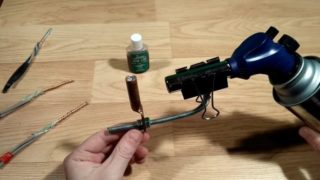
If there is a large scope of work, it is advisable to use crucibles, which are a hollow metal cylinder equipped with a handle for filling with molten solder. This device can be heated with a gas torch or used as a tip on a powerful soldering iron.
The container holds a small amount of molten solder, while it solidifies, a person manages to make several twists.
Precautions
Care should be taken when performing work, as the molten solder can leave severe burns if it hits the skin. All brands of solders contain lead, the vapors of which are toxic to humans. To prevent poisoning, you need to work in a respirator.
When soldering wires, it is forbidden to use acid-containing active fluxes, since after completion of work they require complete removal. Flux residues have a destructive effect on all materials, especially brazing acid and zinc chloride are aggressive for copper.
In general, the work should not cause difficulties, the main thing is to familiarize yourself with the execution technology in advance, prepare all consumables and tools.

